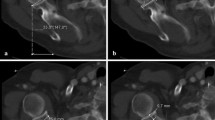Abstract
Objective
The bare spot (BaS) is a central, well-circumscribed focal defect in the glenoid articular surface, with reported adult incidence of 1–2%. We aimed to reassess MRI features of BaS in the pediatric population and determine its etiology.
Materials and methods
A retrospective search of our database from June 2014 to October 2015 was performed for shoulder MRI in patients between 5 and 25 years and then subdivided into four groups: group 1, 5–10 years; group 2, 10–15 years; group 3, 15–18 years; group 4, 20–25 years. BaS was defined as a well-marginated, central defect of increased signal in the articular surface of the glenoid, seen on at least two planes, without evidence of underlying glenoid pathology. Presence, location and size along with clinical indications were documented.
Results
A final cohort of 253 patients revealed 23 BaS, 3.5% in group 1, 20% in group 2, 5% in group 3 and 4% in group 4. There was a significantly higher incidence in group 2 (p = 0.007) compared to group 3 and p = 0.002 compared to group 4. Location was mainly central. Mean size was significantly bigger in group 2 compared to group 3 and 4. Distribution showed the highest number at 14–15 years of age. Instability was higher in groups 3 and 4.
Conclusion
Incidence of BaS in group 2 was significantly higher than in other age groups and higher than in adults. BaS was also larger compared to other populations. These findings support a developmental theory, explained by the centripetal ossification of the glenoid.





Similar content being viewed by others
References
Aigner F, Longato S, Fritsch H, Kralinger F. Anatomical considerations regarding the “bare spot” of the glenoid cavity. Surg Radiol Anat 2004;26(4):308–311.
Barcia A, Rowles D, Bottoni C, Dekker T, Tokish J. Glenoid bare area: arthroscopic characterization and its implications on measurement of bone loss. Arthroscopy. 2013;29(10):1671–5.
Burkhart S, DeBeer J, Tehrany A, Parten P. Quantifying glenoid bone loss arthroscopically in shoulder instability. Arthroscopy. 2002;18(5):488–91.
Burkhart S. The bare spot of the glenoid. Arthroscopy. 2007;23(4):449.
Chauvin N, Jaimes C, Laor T, Jaramillo D. Magnetic resonance imaging of the pediatric shoulder. Magn Reson Imaging Clin N Am. 2012;20(2):327–47.
Conzen A, Eckstein F. Quantitative determination of articular pressure in the human shoulder joint. J Shoulder Elb Surg. 2000;9(3):196–204.
De Wilde L, Berghs B, Audenaert E, Sys G, Van Maele G, Barbaix E. About the variability of the shape of the glenoid cavity. Surg Radiol Anat. 2003;26(1):54–9.
DuBois DF, Omar IM. MR imaging of the hip: normal anatomic variants and imaging pitfalls. Magn Reson Imaging Clin N Am. 2010;18(4):663–74. https://doi.org/10.1016/j.mric.2010.09.003.
Dunham K, Bencardino J, Rokito A. Anatomic variants and pitfalls of the labrum, glenoid cartilage, and glenohumeral ligaments. Magn Reson Imaging Clin N Am. 2012;20(2):213–28.
Fealy S, Rodeo S, Dicarlo E, O’Brien S. The developmental anatomy of the neonatal glenohumeral joint. J Shoulder Elb Surg. 2000;9(3):217–22.
Kieffer EM, Bouchaib J, Bierry G, Clavert P. CT arthrography and anatomical correlation of the bare area of the ulnar trochlear fossa: a risk of misdiagnosis of cartilage ulcerations. Surg Radiol Anat. 2014;36(5):481–6. https://doi.org/10.1007/s00276-013-1200-7.
Kim H, Emery K, Salisbury S. Bare spot of the glenoid fossa in children: incidence and MRI features. Pediatr Radiol. 2009;40(7):1190–6.
Kothary S, Rosenberg Z, Poncinelli L, Kwong S. Skeletal development of the glenoid and glenoid–coracoid interface in the pediatric population: MRI features. Skelet Radiol. 2014;43(9):1281–8.
Kralinger F, Aigner F, Longato S, Rieger M, Wambacher M. Is the bare spot a consistent landmark for shoulder arthroscopy? A study of 20 embalmed Glenoids with 3-dimensional computed Tomographic reconstruction. Arthroscopy. 2006;22(4):428–32.
Ly J, Bui-Mansfield L, Kline M, DeBerardino T, Taylor D. Bare area of the glenoid. J Comput Assist Tomogr. 2004;28(2):229–32.
Motamedi D, Everist B, Mahanty S, Steinbach L. Pitfalls in shoulder MRI: part 1—normal anatomy and anatomic variants. Am J Roentgenol. 2014;203(3):501–7.
Müller-Gerbl M, Putz R, Hodapp N, Schulte E, Wimmer B. Computed tomography-osteoabsorptiometry for assessing the density distribution of subchondral bone as a measure of long-term mechanical adaptation in individual joints. Skelet Radiol. 1989;18(7):507–12.
Nguyen MS, Kheyfits V, Giordano BD, Dieudonne G, Monu JU. Hip anatomic variants that may mimic abnormalities at MRI: labral variants. AJR Am J Roentgenol. 2013;201(3):W394–400. https://doi.org/10.2214/AJR.12.9860.
Rosenberg ZS, Beltran J, Cheung Y, Broker M. MR imaging of the elbow: normal variant and potential diagnostic pitfalls of the trochlear groove and cubital tunnel. AJR Am J Roentgenol. 1995;164(2):415–8.
Rudez J, Zanetti M. Normal anatomy, variants and pitfalls on shoulder MRI. Eur J Radiol. 2008;68(1):25–35.
Santori N, Villar RN. The iliopubic groove: a possible consequence of incomplete triradiate fusion. Two case reports. J Anat. 1997;191(Pt 3):461–3.
Scheuer L, Black S. “The pectoral girdle.” Developmental juvenile osteology. San Diego: Elsevier Academic Press; 2000. p. 252–71. Print
Testut, L, Jacob O. Traité d’anatomie topographique avec applications médico-chirurgicales. Paris, 1921.
Tillman B. A contribution to the function morphology of articular surfaces. New York: Thieme; 1978.
Wang AA, Mara M, Hutchinson DT. The proximal ulna: an anatomic study with relevance to olecranon osteotomy and fracture fixation. J Shoulder Elb Surg. 2003 May-Jun;12(3):293–6.
Warner JJ, Bowen MK, Deng XH, Hannafin JA, Arnoczky SP, Warren RF. Articular contact patterns of the normal glenohumeral joint. J Shoulder Elb Surg. 1998;7(4):381–8.
Zember J, Rosenberg Z, Kwong S, Kothary S, Bedoya M. Normal skeletal maturation and imaging pitfalls in the pediatric shoulder. Radiographics. 2015;35(4):1108–22.
Author information
Authors and Affiliations
Corresponding author
Ethics declarations
Conflit of interest
The authors declare that they have no conflict of interest.
Rights and permissions
About this article
Cite this article
Djebbar, S., Rosenberg, Z.S., Fitzgerald Alaia, E. et al. Imaging features of glenoid bare spot in a pediatric population. Skeletal Radiol 47, 45–50 (2018). https://doi.org/10.1007/s00256-017-2755-x
Received:
Revised:
Accepted:
Published:
Issue Date:
DOI: https://doi.org/10.1007/s00256-017-2755-x




